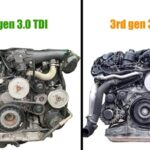The U0100 diagnostic trouble code (DTC), often described as “Lost Communication with ECM/PCM A,” indicates a critical communication breakdown between your car’s Engine Control Module (ECM) or Powertrain Control Module (PCM) and other essential modules. Understanding this code is crucial for effective troubleshooting and repair. This comprehensive guide delves into the causes, symptoms, diagnostic procedures, and potential fixes for the U0100 code.
Decoding the U0100 Code: What Does It Mean?
The U0100 code signals a disruption in the data flow between the ECM/PCM – your car’s brain – and other modules responsible for critical functions like fuel injection, transmission control, and emissions. This communication failure can lead to various performance issues and even prevent your car from starting. The “A” designation typically signifies a specific communication circuit or protocol affected, although its precise meaning can vary depending on the vehicle manufacturer.
Common Causes of U0100 Lost Communication
Several factors can contribute to the U0100 error code. Here are some of the most frequent culprits:
1. Malfunctioning ECM/PCM
A faulty ECM/PCM itself is a potential root cause, requiring replacement or reprogramming.
2. Wiring Harness Issues
Damaged, corroded, or loose wiring within the communication network can disrupt signal transmission, triggering the U0100 code.
3. Faulty Control Module Circuit
A problem within the circuitry of a specific control module can hinder communication with the ECM/PCM.
4. Data Bus Malfunction
The data bus, acting as the communication highway between modules, can malfunction due to shorts, opens, or other damage.
5. Low Battery Voltage
Insufficient battery voltage can disrupt the proper operation of the ECM/PCM and other modules, leading to communication errors.
Recognizing the Symptoms of U0100
The U0100 code often manifests through noticeable symptoms, including:
1. Illuminated Check Engine Light
The check engine light is a common indicator of various DTCs, including the U0100.
2. No-Start Condition
A communication breakdown can prevent the engine from starting altogether.
3. Erratic Engine Performance
Rough idling, misfires, or reduced power can result from the U0100 code.
4. Transmission Problems
Shifting issues or limp mode operation might occur due to communication disruptions.
Diagnosing the U0100 Code
Accurately diagnosing the U0100 code necessitates a systematic approach:
1. Retrieve Diagnostic Trouble Codes
Use an OBD-II scanner to retrieve stored DTCs, confirming the presence of the U0100 code.
2. Visually Inspect Wiring and Connectors
Carefully examine the wiring harness and connectors for any visible damage, corrosion, or loose connections.
3. Check Battery Voltage
Ensure the battery voltage is within the specified range for proper module operation.
4. Perform Network Communication Tests
Utilize a professional-grade scan tool to test the communication network integrity and pinpoint the source of the failure. This may involve using an oscilloscope to analyze communication signals.
Fixing the U0100: Repair Strategies
Addressing the U0100 code requires pinpointing the underlying cause and implementing the appropriate fix:
1. Repair or Replace Wiring and Connectors
Address any damaged or corroded wiring and connectors.
2. Address Faulty Modules
Replace or reprogram malfunctioning modules identified during diagnosis.
3. Resolve Data Bus Issues
Repair or replace damaged components within the data bus system.
4. ECM/PCM Replacement or Reprogramming
In some cases, a faulty ECM/PCM may require replacement or reprogramming by a qualified technician.
Conclusion: Addressing the U0100 for Optimal Performance
The U0100 code highlights a critical communication failure within your vehicle’s electronic control system. Prompt diagnosis and repair are essential to prevent further damage, restore optimal performance, and ensure safe operation. While some fixes can be addressed by experienced DIYers, complex issues may necessitate professional assistance. Don’t underestimate the importance of this code – addressing it swiftly ensures a smoothly running vehicle.


